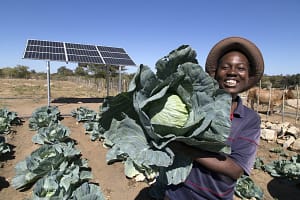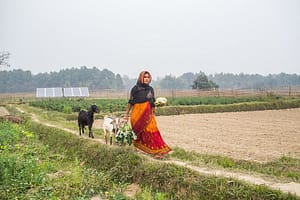Impact of SKY: A Perspective of Women Farmers
Kriti Sharma, Deepak Varshney, and Darshini Ravindranath

A women farmer highlighting the challenges faced when using the Solar Irrigation Pump. Photo: Sahil Wadhwani/ IWMI
Introduction
The agriculture sector in India, as per the India Energy Outlook, accounts for a staggering 80% of the country’s water demand. Within the total cultivable area, 51% relies on rainfed irrigation while the remaining 49% depends on irrigation systems. Out of the 26 million water pumps in use, 9 million are diesel-powered, with the remaining 17 million operating on electricity (mostly derived from fossil fuels). As we navigate the intricate nexus of water demand, irrigation practices, and the environmental impact of powering irrigation, it becomes imperative to identify sustainable energy solutions. There is a global shift towards sustainable energy systems and these systems, including solar, wind, biomass, small-scale hydro, have huge potential to minimise emissions from agriculture while supporting resilient livelihoods. The adoption of Solar Irrigation Pumps (SIPs) has gained significant attention in recent years, providing a clean alternative for farmers reliant on diesel pumps, especially in areas without access to electricity. One key concern raised in the literature on SIPs relates to groundwater extraction, given the marginal cost of pumping is zero. However, the adoption of grid-connected SIPs allows farmers to feed surplus solar power back into the grid, thereby augmenting their farm income. In comparison to diesel generators, which require manpower to operate, SIPs offer the advantage of ease of operation and several unintended benefits, particularly for women farmers. The role of women in agriculture is significant. Despite their significant involvement in various agricultural activities, such as sowing, transplanting, and post-harvest operations, the value they bring often goes unnoticed.
 For example, women undertake labor-intensive tasks like weeding, transplanting, and milling in rice cultivation, particularly due to the outmigration of male farmers seeking better job opportunities in urban areas. Women, especially from marginalized social groups, also manage and maintain water sources for production, such as cleaning water channels and maintaining bunds (Mitra and Rao 2019). In Gujarat alone, 47% of women are engaged as agricultural laborers, and 22% are cultivators, highlighting their substantial presence in the agricultural workforce (Economics & Statistics Division of the Department of Agriculture & Farmers Welfare, 2023).
For example, women undertake labor-intensive tasks like weeding, transplanting, and milling in rice cultivation, particularly due to the outmigration of male farmers seeking better job opportunities in urban areas. Women, especially from marginalized social groups, also manage and maintain water sources for production, such as cleaning water channels and maintaining bunds (Mitra and Rao 2019). In Gujarat alone, 47% of women are engaged as agricultural laborers, and 22% are cultivators, highlighting their substantial presence in the agricultural workforce (Economics & Statistics Division of the Department of Agriculture & Farmers Welfare, 2023).
The adoption of SIPs in India began in the 2010s through national and state-level programs, resulting in over 2.7 lakh SIPs currently in operation across the country. However, the specific role of women in the adoption of solar irrigation and its impact on them remains largely undocumented. This note aims to address this gap by documenting impact stories from the field, particularly from the perspective of female farmers. SKY and Grid-Connected SIPs



We focus on the Suryashakti Kisan Yojana (SKY) which is a state-level grid-connected SIP scheme, designed to benefit 4,500 farmers in Gujarat. This initiative aims to provide clean energy for irrigation and offers farmers the opportunity to sell excess electricity to the grid. The scheme stands out by providing a solar panel capacity at 1.25 times the current contracted load of the irrigation pump, enhancing the farmers’ ability to generate surplus electricity. In terms of the financial model, participants are required to contribute 5% of the total cost upfront, while the government of Gujarat guarantees a 65% loan. Additionally, a central subsidy covers 30% of the total cost, making the scheme financially viable for farmers. A unique feature of SKY is the Evacuation-Based Incentive (EBI),
introduced to motivate farmers to export electricity. Under this incentive, farmers receive Rs.3.5 per kWh for each unit of electricity exported to the DISCOM. An additional Rs.3.5 per kWh is given as an EBI for every unit of electricity sold. Thus, the scheme not only promotes clean energy but also makes a targeted effort to address the critical issue of sustainable groundwater use in the agricultural sector. The SKY-enrolled farmers receive 12 hours of daytime electricity unlike the 8-hour supply to their non-SKY counterparts. To comprehend the specific advantages of SKY grid-connected SIPs from the perspective of female farmers, we conducted field visits in the Anand and Botad districts of Gujarat. These visits aimed to gain insights into how this innovative approach to irrigation and energy provision, impacts women actively involved in agricultural activities.
Unveiling the Significance of Daytime Power
 One of the notable benefits emphasized by female farmers during our field visits is the availability of reliable daytime power facilitated by grid-connected SIPs. This improvement has led to a significant reduction in drudgery for women engaged in agricultural activities. It also ensures that irrigation and farm-related tasks can be efficiently carried out during daylight hours, providing female farmers with more time during the day for household chores and other productive activities. Thus, providing them a better balance between domestic responsibilities and agricultural work.Due to a reliable and constant supply of electricity, I can water my cotton fields on time, unlike earlier without solar power, which
One of the notable benefits emphasized by female farmers during our field visits is the availability of reliable daytime power facilitated by grid-connected SIPs. This improvement has led to a significant reduction in drudgery for women engaged in agricultural activities. It also ensures that irrigation and farm-related tasks can be efficiently carried out during daylight hours, providing female farmers with more time during the day for household chores and other productive activities. Thus, providing them a better balance between domestic responsibilities and agricultural work.Due to a reliable and constant supply of electricity, I can water my cotton fields on time, unlike earlier without solar power, which had a negative impact on the yield. I also had to stay awake during the night to visit the field, which resulted in minor foot injuries from the small pebbles and gravel on the poorly lit pathways. The SKY has been beneficial for us, reported a female SKY farmer who had been growing cotton on her farm before the SKY scheme. Another female farmer added, “With 12 hours of daytime electricity, I am able to allocate time to fodder production and collection to feed my cattle. I can also take better care of my cattle than before and have started selling milk to the neighbors.” A female farmer from Piplav village of Anand district mentioned, “I wish to have solar because of the 12-hour daytime electricity feature”. Intensification of Agriculture
had a negative impact on the yield. I also had to stay awake during the night to visit the field, which resulted in minor foot injuries from the small pebbles and gravel on the poorly lit pathways. The SKY has been beneficial for us, reported a female SKY farmer who had been growing cotton on her farm before the SKY scheme. Another female farmer added, “With 12 hours of daytime electricity, I am able to allocate time to fodder production and collection to feed my cattle. I can also take better care of my cattle than before and have started selling milk to the neighbors.” A female farmer from Piplav village of Anand district mentioned, “I wish to have solar because of the 12-hour daytime electricity feature”. Intensification of Agriculture












